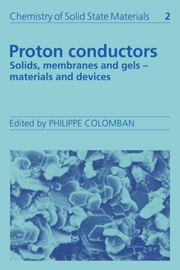Book contents
- Frontmatter
- Contents
- List of contributors
- Preface
- Symbols
- I HYDROGEN BOND AND PROTONIC SPECIES
- II MATERIALS: PREPARATION, STRUCTURES AND PROPERTIES
- III PROTON DYNAMICS AND CHARGE TRANSPORT
- IV PROTON DIFFUSION MECHANISMS
- V DEVICES
- 32 Applications of perfluorinated proton conductors (Nations)
- 33 Synthesis of polycrystalline H3O+ and NH4+ -β″/β-Al2O3 and potential applications in steam-electrolysis/fuel-cells
- 34 Fuel-cells, steam-electrolysis for hydrogen production and hydrogen separation using high temperature protonic conductors
- 35 Ice-based devices
- 36 Solid-state gas sensors operating at room temperature
- 37 All solid-state protonic batteries
- 38 Applicatios of proton conductors in electrochromic devices (ECDs)
- 39 Supercapacitors and interfacial charge accumulation devices
- Index
39 - Supercapacitors and interfacial charge accumulation devices
Published online by Cambridge University Press: 04 May 2010
- Frontmatter
- Contents
- List of contributors
- Preface
- Symbols
- I HYDROGEN BOND AND PROTONIC SPECIES
- II MATERIALS: PREPARATION, STRUCTURES AND PROPERTIES
- III PROTON DYNAMICS AND CHARGE TRANSPORT
- IV PROTON DIFFUSION MECHANISMS
- V DEVICES
- 32 Applications of perfluorinated proton conductors (Nations)
- 33 Synthesis of polycrystalline H3O+ and NH4+ -β″/β-Al2O3 and potential applications in steam-electrolysis/fuel-cells
- 34 Fuel-cells, steam-electrolysis for hydrogen production and hydrogen separation using high temperature protonic conductors
- 35 Ice-based devices
- 36 Solid-state gas sensors operating at room temperature
- 37 All solid-state protonic batteries
- 38 Applicatios of proton conductors in electrochromic devices (ECDs)
- 39 Supercapacitors and interfacial charge accumulation devices
- Index
Summary
Introduction
The energy consumption of electronic devices has decreased gradually with progress in integrated circuit technology. The stable working voltage required for power supplies is today considerably lower than in the first transistor devices. Furthermore, the development of amorphous silicon films makes possible a new design for many portable systems. The demand for miniaturized high energy density and low leakage current capacitors as, for example, a stand-by power source for RAM devices, for actuators or sensors as well the substitution of batteries by long-life power supplies offers new opportunities (pace-makers, watches where the supercapacitor is associated with a balance-wheel…) for capacitors using the electric double layer developed at a highly polarizable, blocking electrode/ electrolyte interface.
The first attempts to achieve such a device were made in the 1970s. The cell had a non-symmetric Ag/RbAg4I5/C structure with a double-layer capacitance at the carbon electrode in the range of 10–40 μF cm–1 interface area. However, due to the redox reaction, the working voltage was too low (<0.7 V) for the electronic devices of the time. Furthermore, the reversibility of the Ag electrode was poor and it was difficult to use fully the surface area of the ultrafine carbon. More recently, double-layer capacitors using acidic solution (H2SO4) as liquid electrolyte were developed by NEC (Nippon Electric Co. Ltd). A liquid electrolyte allows most of the surface area of the carbon electrode to be used. The electrical characteristics of the devices can be classified in relation to the properties of each material as follows.
- Type
- Chapter
- Information
- Proton ConductorsSolids, Membranes and Gels - Materials and Devices, pp. 567 - 572Publisher: Cambridge University PressPrint publication year: 1992
- 2
- Cited by



